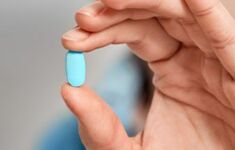New study on condom use among queer men unveils some surprising & alarming findings
Is it time to make condoms fashionable again?


A new study has confirmed what most sexually active gay men will already know: Less of us are using condoms when we have sex compared to ten years ago.
The study, published in AIDS and Behavior, was conducted by researchers at the University of Washington. It drew its data from the American Men’s Internet Survey (2014-2019). It looked specifically at men who have condomless anal sex with men who are not on PrEP.
The number of men in the study having condomless sex rose by 2.2% each year. However, the rise was greater in younger men (rising 7.2% per year for those aged 15-24 years) and Hispanic men (rising 18%).
How about we take this to the next level?
Subscribe to our daily newsletter for a refreshing cocktail (or mocktail) of LGBTQ+ entertainment and pop culture, served up with a side of eye-candy.
Overall, condom use remained more popular than PrEP. This might be partly due to barriers to obtaining PrEP, among other factors. Around 15% of the men were taking PrEP.
The vast majority of men questioned believed condoms to be “very effective” (60%) or “somewhat effective” (36%) at preventing HIV transmission.
However, 24% said they “never” used condoms, compared to 50% who said they “always” or “sometimes” used them. The remainder said they rarely used them.
Clearly, there is a large number of guys having condomless sex who are not on PrEP. If their partner is HIV positive and undetectable, they cannot pass on the virus. However, not everyone knows their HIV status or is on treatment.
Besides HIV, condoms can also help prevent the transmission of other STIs. The rise in gonorrhea and syphilis diagnoses in the US in recent years is in part related to declining condom use.
Lead author, Steven Goodreau, a professor of anthropology, praised PrEP but also highlighted the benefits of condoms.
“Different things work for people in different circumstances and times of their lives. PrEP has many benefits. It’s something that doesn’t have to happen in the moment, something an individual can decide on instead of having to negotiate with a partner. Some people really don’t like condoms and aren’t going to use them, so PrEP provides another option for them.
“But like most pharmaceutical interventions, it means people need to know about it and be continuously tied to the healthcare system.”
“There are all sorts of things happening in people’s lives — from unstable housing to dealing with mental health and substance use — that make taking a pill every day not the easiest thing to do. So, PrEP has positives but also challenges,” he said in a press statement.
“The same with condoms. They’re far cheaper and much easier to access. For some people the lack of daily regimen is a plus. They prevent a much wider range of sexually transmitted infections, not just HIV. But they also take their own form of planning and negotiation. In the end, I see both as key to lowering HIV transmission rates.”

The Biden administration announced in 2022 that it was looking at launching a 10-year $9.8 billion nationwide delivery program for PrEP. It’s part of efforts to end HIV transmission by 2030.
Goodreau believes that although that although such initiatives are great, we must also promote condom use.
“Before PrEP came out, HIV prevention for gay and bisexual men had condoms as a central pillar — perhaps the central pillar — for about three decades. Of course, we were all tired of talking about them. So, I get why, when PrEP came out, it was seen as a miracle and the pendulum swung in that direction. But it’s a decade into PrEP delivery and I think it’s time to look at that and say, ‘Is it time for the pendulum to swing back a bit?’”
He continued, “I’d like people to have open, honest, sincere conversations about how much condom promotion we’ve been doing. What messages have we been putting out? What haven’t we been doing, and why? Is it because there aren’t folks who would benefit from those conversations, or are we just tired of having them?”
He also said that learning about safer sex in schools is of vital importance.
“LGBTQ+ inclusive sex education is extremely important. Only about half of U.S. high schools have it, and that’s a key first place for young, gay and bisexual men to learn about the different prevention methods and what would work for them given where they are in life.”
He also suggested that some dating apps could do more to highlight condom use as a preference.
“In the end, it’s key to remember that things like condom use are highly subject to social norms — many people use what they see and hear from their peers and beyond as a guide for their own decisions,” he said. “Even just a little bit more attention to the topic may help to get many of those conversations started again.”
Related:
This state just took a major step forward in expanding access to PrEP. Will other states follow suit?
It’s a move to further bring down HIV transmission.
This popular gay hotspot has seen a 95% drop in new HIV cases. Here’s how they did it.
One of its recent HIV awareness adverts is aimed at older men traumatized by living through the epidemic.

 Mark
Mark 







